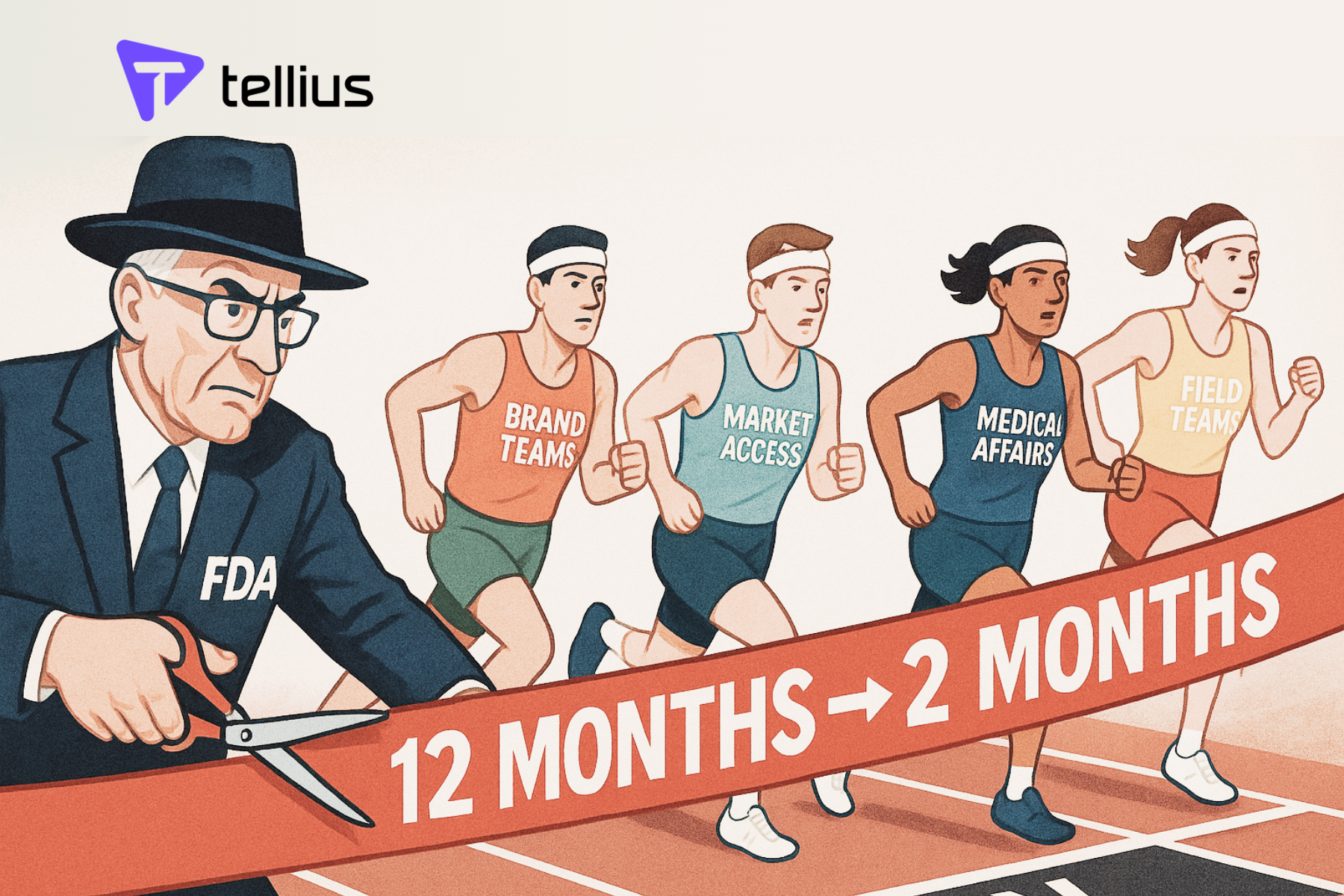Pharma commercial field sales at Telliuspeed: Why your target lists might be misleading your reps

Your reps are knocking on the wrong doors—and they don’t even know it. Quarterly reports can’t keep up with fast-changing HCP behavior. By the time your field managers realize a territory’s underperforming, competitors have already filled the gap. In 2025, commercial field teams need answers at the speed of the market, not after the quarter’s closed.
Pharma commercial teams are under pressure like never before – tighter regulations, compressed timelines, and less headcount. Reps juggle more products and ever-changing physician preferences, all while adhering to strict compliance rules. Data lives in silos — CRM in one corner, Rx trends in another, marketing on its own island — and no one’s connecting the dots fast enough. The modern commercial mandate is clear: do more with less, and do it faster.
But even with rising expectations, many teams are still stuck in old routines. Commercial leaders wait days to weeks for analysts to piece together siloed data into decks and sheets. Too often, decisions are made using lagging indicators or informal feedback rather than timely, data-backed insights. And while annual plans are carefully built, they’re tough to adjust mid-cycle when the market shifts. That disconnect between strategy and execution? It’s why more teams are rethinking how they work.
If you’re a brand lead, sales manager, or even a rep, you’ve probably felt the pain of slow data, clunky targeting, and rigid plans. Don’t worry – you’re not alone, and it doesn’t have to be this way. Let’s break down the big three headaches and how we can fix them so you can crush your numbers (and maybe get home by 6 for once).
When insights take forever (and you don’t have forever)

Let’s get real: your sales reps in the field aren’t waiting around. They’ll make gut calls even after your headquarters does tons of data crunching to tell reps where to go and who to see. Can we blame them? Reps have already moved on; they’re not waiting for HQ to decipher what’s wrong (e.g. is it a targeting issue? A messaging misfire? Something else?)
Traditional BI tools often only show what happened. But modern analytics must deliver answers beyond “what” happened to include “why” it happened and “what next” to do. Since many teams lack this capability, local reps often trust their intuition, personal relationships, and local knowledge. This insight gap means lost time and lost sales.
The Tellius way: Imagine typing a question into a search bar – “Which doctors should Alice (rep in Territory 5) prioritize this week?” – and getting an instant answer with a list of high-potential HCPs. Quick, self-serve insights mean you catch issues before they happen. If a product’s scripts drop on Monday, you know by Tuesday and adjust strategy by Wednesday. We call it Telliuspeed—instant answers to field-level questions.
Reps deserve better than chasing irrelevant doctors

Let’s talk about targeting. Getting pharma reps in front of the right doctors at the right frequency is crucial. We’ve all seen those massive target lists that come down from corporate (generated once a quarter and rarely updated). Typically, it’s an Excel with 500 names that looked good on paper. But on the ground? 😬 Sometimes it even includes doctors who retired years ago, or a vet (yes, that happened) mistakenly listed as a cardiologist. Reps find themselves chasing doctors who have retired, moved, or see few relevant patients. Ouch. Traveling hours to drop off brochures that end up ignored is demoralizing. Every hour spent on a low-potential call or long commute could’ve been reallocated to a higher-priority HCP or a virtual meeting.
Another inefficiency? The old “cover all bases” approach. Picture this: five reps from the same company all visit the same clinic in a week, each pushing a different drug. The doctor gets overwhelmed and tunes them out. A smarter move is focusing on what the doctor actually needs. If Dr. Garcia mostly treats diabetes, don’t spam her with asthma meds. Targeting should be laser-focused.
The Tellius way: Dynamic targeting driven by data. Specialize reps by product or physician type and align territories to needs. If a new high-prescribing endocrinologist pops up, boom, your reps see it and pay them a visit. If a clinic stops seeing patients in your drug’s category, Tellius drops them off your list. The goal is to make every rep’s to-do list supercharged with real opportunities, not wild goose chases. This way, reps spend time with doctors who matter, not wasting their day (or your budget) on the wrong conversations.
Inflexible planning is planning to fail

Pharma companies know they need to be more responsive – adapting campaigns, reassigning reps, tweaking messages – but their analytics tools haven’t kept up. The consequence is missed opportunities: a slow reaction to a dip in one territory could snowball into a quarter of lost market share.
When you don’t have timely data or the tools to analyze it on the fly, you stick to the original plan even if it’s failing. Marketing might see digital engagement numbers, sales sees call activity, market access sees formulary changes – and these data sets meet only in slides at the quarterly meeting.
If your plan isn’t flexible, you risk missing where the demand shifted. You have to adjust to the wave in real time, not stick to where you wished the wave was. A Pharma 101 principle is to foster a data-driven culture where everyone from rep to VP can see what’s happening and adjust tactics on the fly.
The Tellius way: Set up dashboards that update daily, alerts that ping you when metrics deviate, and cultivate a team mindset of “test, learn, iterate.” Here’s a scenario: The brand team spent weeks crafting the perfect plan for Q1. Target segments, messages, budgets – it’s all laid out. But come February, something’s off. Maybe a competitor launched a new coupon program, or a guideline update changed prescribers’ habits. Suddenly, your picturesque plan needs a pivot. How quickly can you adjust the messaging in the field? Too often, the answer is “not until the next cycle.”
Agile execution is about lots of small course-corrections rather than a few big, rigid moves. Encourage your analytics folks to deliver recommendations, not just reports. Like, “Hey team, looks like the East region is falling behind — let’s try increasing visits to our top doctors there by 20% and see if that helps turn things around.” Small tweaks, big differences.
Tellius treats data as an always-on utility, not a quarterly chore
The common thread in fixing these pains is better access to data and insights. This is where Tellius comes in, augmenting analytics with AI.
- Tellius connects all your fragmented pharma data — from call logs and Rx trends to marketing engagement and market access — and surfaces what you need to know, when you need to know it.
- Tellius natural language querying and automated insights mean anyone – even a field manager with no SQL skills – can get nuanced answers on the fly. Ask a question like “What’s driving the Rx dip this month?” and get a full breakdown: charts, summaries, and pinpointed drivers [Rx volume down mainly because call success rate dropped with pediatricians (–30%) and endocrinologists (–24%) in the West region]. Better yet, Tellius guides reps on next-best actions, scoring and rescoring targets so they focus on high-potential physicians — not retired ones.
- You can drop a term like “coverage” or “frequency” in a query and instantly see how you’re doing on those key KPIs across products or territories. And when something weird happens (like a sudden dip in calls or an upsurge in a competitor’s drug), Tellius proactively alerts you – no more surprises at quarter-end.
When reps have information like that at their fingertips, every call can be optimized – letting teams respond to issues during the quarter, not after it’s over. It’s a virtuous cycle of data-driven coaching.
In pharma, the worst decision isn’t the wrong one, it’s the late one
Adopting these technologies does require a mindset shift. The companies that succeed will be those willing to challenge how things have “always been done” in pharma sales. In doing so, they transform field sales from a sluggish, intuition-led function into an agile, evidence-driven powerhouse.
At the end of the day, commercial pharma field sales is about people – building relationships with HCPs and understanding their needs – but it’s also about data. The teams that blend the two effectively are the ones winning today. If you’ve been nodding along to these pain points, it’s time to demand better tools and processes. Tellius gives you faster insights, smarter targeting, and agile planning. Arm your field teams with intelligence that moves at the speed of pharma. Your reps will thank you, your brand performance will improve, and who knows – you might actually enjoy your next sales meeting when everyone’s on the same page with real insights. And that’s a win for you, your company, and ultimately for patients who get the therapies they need.
Get release updates delivered straight to your inbox.
No spam—we hate it as much as you do!

When insights arrive too late, reps miss the moment to act—whether it's engaging a high-value HCP after a formulary change or identifying a competitor switch.Tellius delivers insights in near real-time, allowing reps to pivot fast and managers to drive impact across regions and territories.
Latency in reporting leads to missed windows of influence. Field teams often wait weeks for answers they needed yesterday.Tellius eliminates this lag by connecting directly to pharma data sources like IQVIA, CRM, and claims data—turning days or weeks of reporting cycles into instant answers.
Targeting fails when it’s based on static rules, outdated activity, or oversimplified segmentation. Success requires a flexible system that adapts to shifting access, behaviors, and regional trends.Tellius uses AI agents and real-time signals to help commercial teams optimize targeting strategies on the fly—no dashboards or analysts required.
Inflexible planning doesn’t account for how fast the market changes. It locks reps into outdated routes, leading to missed opportunities and wasted effort.Tellius brings agility to field planning by enabling dynamic HCP segmentation, automated opportunity analysis, and real-time territory performance tracking.
Tellius connects to all your data sources—internal and external—to give field sales teams a complete picture. That includes syndicated data like IQVIA and Xponent, CRM activity, call plans, formulary and payer access data, TRx/NBRx trends, claims, and internal sales metrics. By unifying these sources, Tellius helps field sales teams optimize everything from target lists to pull-through performance—delivering faster, more informed actions across regions, accounts, and stakeholders.

How Novo Nordisk Unlocks Pharma Commercial Ops Efficiencies with AI Analytics

Learn how Novo Nordisk’s commercial analytics team is leveraging Tellius' AI analytics solution to drive data-driven answers and insights.

What the FDA's New Priority Voucher Program Means for Commercial Pharma Teams

Faster drug approvals are coming. Here's how field sales, market access, and brand teams must adapt—and why AI analytics is no longer optional.

The Guardrails Are Off. What’s Next for CAR-T Access?

With the FDA’s landmark approval of CAR-T therapies like Abecma and Carvykti as earlier-line treatments, the commercial landscape is shifting rapidly. This blog explores the next phase of CAR-T market access and the analytics brand teams need to navigate it. Learn how to forecast pull-through, identify high-opportunity accounts, and guide sales execution using real-world data, segmentation strategies, and AI-powered insights. From payer dynamics to provider referral patterns, find out what it takes to win in a competitive, high-cost therapeutic space.

